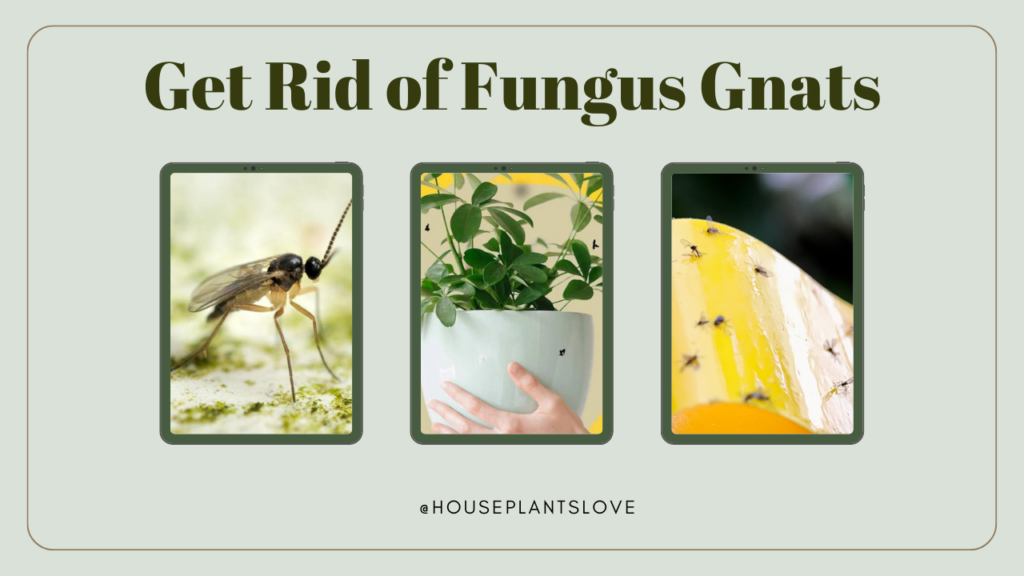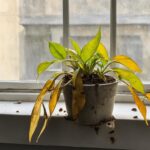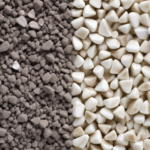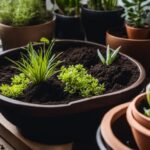How to Get Rid of Flies or fungal diseases on house plants, identify, the life cycle, damage Causes, and how to kill Fungus gnats instantly, prevention
Fungus gnats, also known as house plant flies, are tiny, flying insects that can become a nuisance for indoor gardeners. Houseplants are a beautiful addition to any home, but sometimes, unwanted visitors like fungus gnats can disrupt your indoor gardening bliss. These pesky pests are drawn to the moisture and decaying organic matter present in potted plants, making houseplants particularly vulnerable. They are often found in houseplants, where they can damage the roots and leaves.

What are House Plant Flies?
Fungus gnats (Sciaridae) are small, dark-colored flies that typically measure around 1/8 inch in length. They have black or brown bodies and clear wings. They are commonly found in homes and greenhouses, where they lay their eggs in the soil of potted plants. Fungus gnats are attracted to damp conditions and decaying plant matter such as overwatered houseplants, making indoor plants an ideal breeding ground.
How to Identify Fungus Gnats
These are small, dark-colored flies that closely resemble mosquitoes. You can often spot them hovering around your houseplants or resting on the soil. Additionally, signs of their presence include tiny worm-like larvae in the soil and yellowing or wilting leaves on your plants.
Identifying houseplant flies is crucial for effective control. Look for the following signs:
- Adult Gnats: These are small, dark flies that will often be seen hovering around your plants or resting on the soil.
- Tiny Larvae: Fungus gnat larvae are tiny, white, worm-like creatures with dark heads. They can be found in the top layer of the soil.
- Yellowing or Wilting Plants: Infested plants may exhibit signs of stress, such as yellowing leaves or wilting.
Life Cycle of a Fungus Gnat
Understanding the life cycle of fungus gnats is essential for control:
- Egg Stage: Adult female gnats lay eggs in the soil. These eggs hatch into larvae within a few days.
- Larval Stage: Larvae feed on organic matter and plant roots, causing damage to the plant.
- Pupal Stage: Larvae pupate in the soil, forming a protective cocoon.
- Adult Stage: New adult gnats emerge from the pupae, perpetuating the cycle.
What Causes House Plant Flies?
Fungus gnats are typically drawn to houseplants due to the moist, organic-rich environment they provide. These conditions are ideal for the gnats to lay their eggs, which hatch into larvae that feed on organic matter and plant roots. Overwatering and over-fertilization are common culprits that create the perfect breeding ground for these pests.
You can read the Complete Guide to Watering Indoor plants
What Kills and Gets Rid of House Plant Flies or Fungus Gnats Instantly?
To eliminate fungus gnats instantly, you can use the following things and a few methods, which is mentioned below:
- Yellow Sticky Traps: Place yellow sticky traps near your plants. Fungus gnats are attracted to the bright color and become trapped when they land on a sticky surface.
- Insecticidal Soap: A mixture of water and insecticidal soap can be sprayed directly on the gnats. The soap disrupts their respiratory system, effectively killing them.
- Mosquito Bits with BTI – BTI is harmless to mammals but deadly to gnats’ larvae. To use it, dissolve four tablespoons of mosquito bits in a gallon of water and use this solution for regular plant watering. This method worked exceptionally well.
- Neem Oil: Neem oil is a natural insecticide that can be diluted with water and applied to the soil. It kills the gnats and disrupts their life cycle. Neem oil is a safe and effective way to kill them. Apply the oil to the leaves and stems of your plants as well.
- Beneficial Nematodes: These microscopic organisms can be introduced into the soil to spray on the gnat larvae, effectively controlling the population.
- Pyrethrin: Pyrethrin is a natural insecticide that can be used to kill fungus gnats. It is quick-acting and effective, but it can also be harmful to bees and other beneficial insects.
- Cinnamon Powder- Maybe you think how does cinnamon kill fungus gnats? I will let you know that Cinnamon has antifungal properties and can deter fungus gnats. Sprinkle a thin layer of cinnamon powder on top of the soil to create an inhospitable environment for the pests.
- Orange Peel to Good Use – Dried orange peels placed on top of the soil can deter gnats with their citrusy aroma. Replace the peels as needed to maintain their effectiveness.
In the quest to conquer fungus gnats organically, I found a winning combination of sticky traps and mosquito bits with BTI. These solutions effectively reduced the gnat population in my garden.
Damage Caused by House Plant Flies
Fungus gnats can harm your plants in several ways:
- Root Damage: Larvae feed on plant roots, which can weaken the plant and make it more susceptible to other diseases.
- Reduced Growth: Infested plants may exhibit stunted growth, as their nutrient uptake is compromised.
- Yellowing Leaves: Damage to the roots can result in yellowing or wilting leaves.
Effective Ways to Control House Plant Flies
There are a few things you can do to get rid :
- Reduce watering: They are attracted to moist soil, so it is important to reduce watering your houseplants. Allow the soil to dry out completely between waterings.
- Remove decaying organic matter: They are attracted to decaying organic matter, so it is important to remove any dead leaves or flowers from your houseplants. You should also empty the drip trays under your houseplants regularly.
- Lint Roller to Remove Bugs – For a non-toxic, hands-on approach, use a lint roller to gently roll over the leaves and soil. This can help you capture adult gnats and reduce their population.
- Soil with Sand – A layer of horticultural sand or fine gravel on top of the soil prevents adult gnats from laying their eggs. This physical barrier makes it difficult for the larvae to reach the soil surface.
- Pop Matchsticks into Your Plants – Inserting matchsticks vertically into the soil can help absorb excess moisture, making the environment less appealing to fungus gnats.
Apart from this, you will also need the above-mentioned things to help you to Get Rid of House Plant Flies.
You can also read about Houseplant Pests and How to Treat and Prevent Them
How to Prevent House Plant Flies or Fungus Gnats
There are a few things you can do to prevent fungus gnats:
- Allow the soil to dry out completely between waterings.
- Remove any dead leaves or flowers from your houseplants.
- Empty the drip trays under your houseplants regularly.
- Use a well-draining potting mix.
- Avoid overwatering your plants.
- Inspect your plants regularly for signs of fungus gnats.
What Can You Spray on Houseplants to Kill Flies?
- Neem Oil: Neem oil is a natural insecticide that can disrupt the life cycle of fungus gnats. Dilute neem oil with water as per the instructions on the product label and spray it on your plants. This not only kills the gnats but also deters them from laying eggs.
- Peroxide Spray: Mix one part 3% hydrogen peroxide with four parts water and use it to water your plants. This solution kills gnat larvae while providing extra oxygen to your plant’s roots.
- Make a vinegar trap. Fungus gnats are also attracted to vinegar. To make a vinegar trap, fill a small cup or jar with apple cider vinegar and a few drops of dish soap. Cover the top of the trap with plastic wrap or cheesecloth, and poke a few holes in the top. The gnats will be attracted to the vinegar and will get trapped in the soapy water.
Fungus gnats may try to invade your indoor garden, but armed with these strategies, you can successfully eliminate them and ensure the well-being of your houseplants. By maintaining proper watering and fertilization practices, monitoring your plants regularly, and using these natural remedies, you can keep your indoor oasis free from unwanted flying visitors and enjoy the lush beauty of your houseplants.
FAQ: How to Get Rid of Fungus Gnats in Indoor Plants
What are fungus gnats, and why are they a problem for indoor plants?
Fungus gnats are small, flying insects that are commonly found around indoor plants. They lay their eggs in moist soil, and the larvae feed on organic matter, including plant roots. While adult gnats are more of a nuisance, the larvae can harm plant roots, leading to weakened and stressed plants.
How do I know if I have a fungus gnat infestation?
Signs of a fungus gnat infestation include tiny, black flies hovering around your plants, especially when disturbed, as well as yellowing or wilting of the plant. You may also notice small, white larvae in the soil when you water the plant.
How do I get rid of fungus gnats ASAP in my houseplants in the UK??
The fastest way to get rid of fungus gnats involves a combination of methods:
1. Allow the soil to dry out between waterings to disrupt the gnat life cycle.
2. Use sticky traps to catch adult gnats and reduce their population.
3. Apply a hydrogen peroxide solution (1 part hydrogen peroxide to 4 parts water) to the soil to kill larvae.
What is the fastest way to get rid of gnats in plants?
The quickest way to eliminate gnats is by implementing a multi-pronged approach:
1. Remove the top layer of soil to discard larvae and eggs.
2. Water the plants with a mixture of neem oil and water (1 teaspoon of neem oil per quart of water).
3. Keep the soil consistently dry to prevent the development of gnats.
Are there any natural remedies to control fungus gnats?
Yes, several natural remedies can be effective:
1. Use cinnamon powder on the soil surface, as it has antifungal properties.
2. Apply a layer of sand on top of the soil to prevent adult gnats from laying eggs.
3. Allow the soil to dry out, as fungus gnats thrive in moist conditions.
Can I use chemical insecticides to get rid of fungus gnats?
While chemical insecticides are an option, it’s recommended to try natural and less toxic methods first. If you choose to use chemicals, select those labeled for indoor plants, and follow the instructions carefully to avoid harming your plants or yourself.
Does Dish Soap Kill House Plant Flies or fungus gnat?
Yes, a mixture of dish soap and water can be an effective DIY solution. Mix a few drops of dish soap with water and spray it onto the top layer of soil. The soap breaks the surface tension, making it difficult for adult gnats to lay their eggs.




